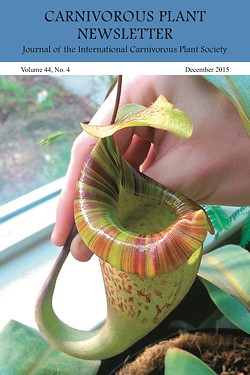International Carnivorous Plant Society
Carnivorous Plant Newsletter Archive
Several pygmy Sundew species possess catapult-flypaper traps with repetitive function, indicating a possible evolutionary change into aquatic snap traps similar to Aldrovanda
Siegfried R. H. Hartmeyer and Irmgard Hartmeyer
Carniv. Pl. Newslett. 44(4):172-184
Published 18 November 2015
https://doi.org/10.55360/cpn444.sh284
Abstract
Keywords: Drosera, pygmy Sundew, Aldrovanda, Dionaea, Droseraceae, Collembola, carnivorous plant, catapult-flypaper trap, snap trap, snap-tentacle, functional morphology, phylogeny
Article Citation
Siegfried R. H. Hartmeyer and Irmgard Hartmeyer. 2015. Several pygmy Sundew species possess catapult-flypaper traps with repetitive function, indicating a possible evolutionary change into aquatic snap traps similar to Aldrovanda. Carniv. Pl. Newslett. 44(4):172-184. https://doi.org/10.55360/cpn444.sh284
Page views: 995
©2025 International Carnivorous Plant Society
www.carnivorousplants.org
This page is maintained by John Brittnacher.
Please contact us at our membership website, icps.clubexpress.com.
Privacy: The Carnivorous Plant Newsletter Archive website does not track users.

